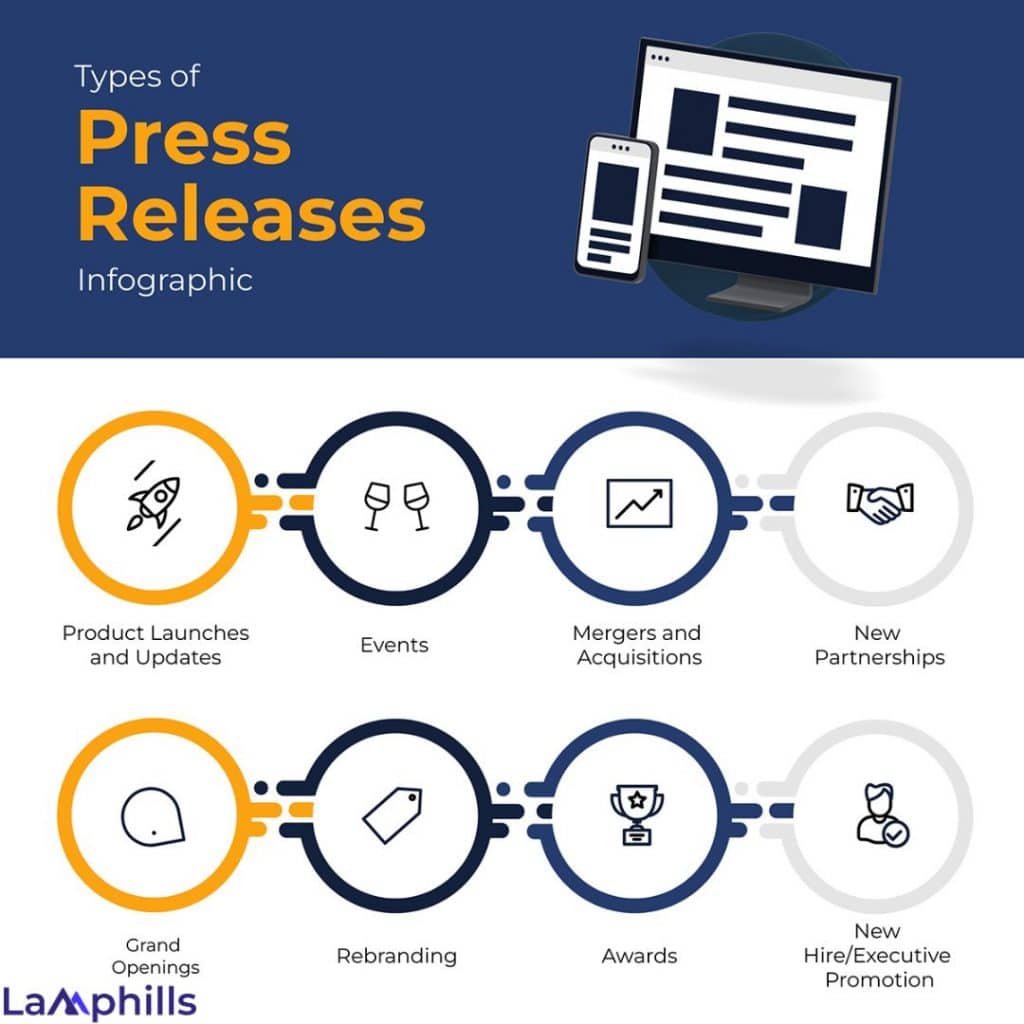Remember the frantic hurry to send a press release, only to be met by crickets from journalists? Finding the best time to send a press release might be like chasing a moving target. But don’t worry, fellow public relations fighters! There’s a method to this madness. Understanding media habits and maximizing timing can help you transform your press releases from digital dust to newsworthy attention magnets
As a PR Specialist at Lamphills, I’ve seen the impact of a well-timed press release. A recent study by Prowly examined over 55,000 press releases and discovered that open rates peak between 10:00 AM and 2:00 PM in the recipient’s time zone. This statistic emphasizes the significance of accounting for the journalist’s workflow.
But timing extends beyond the hour. Let’s delve further and discover the untapped potential of strategic press release scheduling, which can elevate you from a press release slinger to a media relations master capable of maximizing the impact of your newsworthy announcements.
Key Takeaways
- Sending press releases in the morning, ideally between 8 and 10 AM in the journalist’s local time zone, ensures the release tops their morning inbox, increasing the likelihood of coverage.
- It’s crucial to adjust the sending time to the local time zone of the recipient journalist to ensure the release is not buried under other emails or missed due to being sent too late in the day.
- Sending press releases at non-standard times, such as a few minutes past the hour, can help avoid the bulk of releases sent via automated systems and increase visibility.
- While common advice suggests sending releases during mid-week mornings, data from studies reveals that releases sent on Fridays at 3 PM can garner attention over the weekend, challenging traditional timing norms.
- Using a Press Release Timing Template helps in planning the optimal time to send releases based on historical data and targeted audience behavior, enhancing the effectiveness of your PR strategy.

What is the Best Time of Day To Send a Press Release?
Let’s start with the smallest unit of time: the time of day. Should you send out your press release in the evening? What about the morning? What about the lunch break?
There are several factors to consider here, so let’s break it down.
#1. Send out your press release in the morning
First and foremost, you want to send your press release in the morning. Typically, this occurs between 8 and 10 a.m., following the morning coffee and clock-in but before the lunch break.
Why this time frame? It’s the time when journalists review all of their tips and possible articles and decide what to cover for the day. You want your press release to be toward the top of their inbox, so it is one of the first potential stories they view, and they are more likely to include it in their daily content strategy.
- Do not send it too early! The earlier you send it, the further down the inbox it will go as everyone else sends their press releases after you.
- Do not send it too late, either. The later you send it, the more urgent it must be because the content calendar has likely already been established and the writer has begun composing the story. They no longer have the time or desire to rearrange their schedules for anything less than outstanding news.
#2. Remember to compensate for the journalist’s local time
This is critical. This 8-10 a.m. timeframe is not your time; it is the time of the journalist to whom you are sending your press release. That implies you must know where the journalist is and what hours they are most likely to be working. If you send your press release at 8 a.m. EDT but your writer is in California, it will be buried deep in their inbox. On the other hand, if you send it at 8 a.m. PDT and your journalist is in NYC, it will not appear for them until almost lunchtime.
This is especially difficult for international and global corporations, as well as situations where coverage must be obtained all over the world. Having a resource on hand to keep track of time throughout the world can be really beneficial.
#3. Advanced technique: avoid sending at rounded times
Many companies utilize outreach software to send out press releases regularly. That way, you can have your press release ready to go at 5 p.m. the night before but schedule it to send at the optimal time the next day.
However, there is a quirk with these types of apps: many of them schedule their sends for a rounded number of minutes through the hour. It’s normally on the hour, half-hour, or every 15 minutes, but you can also find some occasions every 10 or 5 minutes. It’s uncommon to find software that allows you to schedule down to the minute, simply because it’s more difficult for a system to send those emails so accurately.
This means that journalists can count on an influx of press releases every hour, half-hour, and quarter-hour. So, if your press release appears outside of such clusters, it is more likely to stand out and receive more attention.
Lamphills can help you research key media outlets, develop a strategic press release calendar, and craft compelling press releases that resonate with journalists and capture media attention.
Understanding Standard Advice
The majority of advice on this topic is very typical. Common knowledge advocates sending press releases during the weekday, preferably Tuesdays through Thursdays, and avoiding weekends and holidays when readership may drop. Mornings are often preferred, particularly around 9 a.m., when the day’s tempo rises up but is not at its height. However, this usual counsel does not always hold up under inspection.
Research and data from various media monitoring techniques provide a more detailed view. For example, a 2022 study by Global Newswire found that press releases sent on Tuesdays had a slightly greater engagement rate, while those released on Fridays at 3 p.m. attracted more attention throughout the weekend, contradicting customary advice. This mismatch highlights an important point: the nature of the news and its importance can influence the best release time significantly more than just following general patterns.
The Best Day of the Week to Send a Press Release
There is little unanimity on the best day of the week to send out press releases. Some may argue that Friday affords newspapers the entire weekend to prepare content for publishing at the beginning of the week. Others argue that Friday is already too late – because who hasn’t checked out by Friday? – and should send it sooner. We can all agree that sending on the weekend is a fool’s errand.
Monday, Tuesday, and Wednesday are the most common recommendations.
Why is this happening? The earlier you send out your press release, the more time you have to have your story covered.
Monday is frequently the best day because it marks the beginning of a new week. Journalists’ weekly publication calendars may not be fully booked yet, giving them more time to cover more stories, resulting in a higher proportion of press releases sent out that day receiving coverage.
Of course, this is not general. Monday is packed because many people believe it is the best day. Perhaps Tuesday is a better day for your announcement. Opinions on this topic differ, which is why the Monday-Tuesday-Wednesday block is popular.
Read Also: How To Send a Press Release: Your Personal Guide to Making Waves in the Media
Consider the fact that there is often a lead time. The journalist must decide on a story and may even pitch it to an editor. It must be approved, researched, written, and revised. Images need to be located and linked. It should be scheduled and published. All of this takes time, and it is unlikely to happen in only a few hours. A press release sent on Monday may not result in a story until Wednesday or Thursday.
Exceptions to the Rule: Embargos and High-Profile Coverage
In general, the conventional time rules apply, although there are several circumstances where they cannot be followed.
One example is when you have an embargo on press coverage and want to prepare it ahead of time. For example, if you want your story to be revealed on Monday, you can’t really send out a press release on Monday, can you?
Well, not quite. Often, the best schedule is to send it out the previous Monday; this gives the journalist a full week to organize and schedule the piece.
Another reason you may be allowed to “skip the line” is if your organization is well-known and has a significant announcement. However, these are the kinds of situations that do not follow the guidelines. Apple can send out a press release whenever they want and receive quick coverage just because they are Apple.
Similarly, crisis events may bypass the line. If your organization experiences a data breach, a press release about it is significant enough that it does not follow the regular time norms.
The Best Time of the Month to Send a Press Release
Factors are largely consistent from week to week. It doesn’t really matter if you send your press release on Tuesday the 2nd or Tuesday the 27th.
However, there are a few reasons why you would wish to choose a specific time of the month, and they are mostly related to other timing considerations.
- If your announcement is for something that will be released on the first of the month, issuing your press release toward the end of the previous month may be preferable.
- If you want to gain coverage in a print journal that is published in the first week of the month, you must submit your piece by the deadline, which is normally halfway through the previous month.
- If there are any special monthly events, such as holidays, you may wish to plan your schedule around them.
However, the time of the month isn’t nearly as essential as the time of the week or the day, which is why many studies ignore it.
The Best Time of Year to Send a Press Release
The time of year is only essential for cultural reasons. They may or may not be relevant to the content of your press release. Of course, if you have months of lead time, you can be quite specific about the best time to make your announcement.
Consider:
- Holidays such as Halloween, Thanksgiving, Black Friday, Cyber Monday, Christmas, and New Year’s are widely covered during the end-of-year season. It can be very crowded.
- Seasonal changes, especially occasions such as Memorial Day and Labor Day, might be jam-packed with seasonal announcements and may not be the best time for you.
- Whether or if you attend industry conferences, the press of material has an impact on journalists. Avoid them if possible.
- Quarterly financial statements and other reports from firms frequently receive a lot of attention, so their deadlines might be tight as well.
- Sending on a holiday, of course, is similar to delivering mail to a vacant address; your journalists are at home with their families and will not receive your release for a day or more.
In general, it’s best to choose a time when there isn’t much going on, just to reduce the amount of competition for your press release.
How Far in Advance to Send a Press Release
In general, the more lead time you can give a story, the easier it will be for a journalist to include it in their content plan and give it the coverage it deserves. Two to three weeks is usually the golden spot; it’s enough time to have a clear future content calendar, but not so long that it feels like “old news” and isn’t thrilling.
This is partly determined by the scope of your coverage. The more reporters you send your press release to, the more time you’ll need to get all of those emails and communications in place. Embargos and timed drops must be synchronized as well. Remember that a shorter deadline can cause FOMO; no journalist wants to miss out on the chance to be the first to arrive at the party.
There is considerable variance here, of course. Print magazines may require far longer lead time, particularly if they are published quarterly. In contrast, if you’re trying to capitalize on a trending topic, you may not have much lead time; you need to get your release out as soon as possible before the trend fades.
Media Landscape Calendar
Early in my work, I sent out press releases around the clock, hoping to capture someone’s attention. Unfortunately, my inbox was overloaded with out-of-office responses, and my press releases ended up in the digital graveyard.
This encounter prompted me to create the Media Landscape Calendar. This methodology allows us to better understand the editorial calendars and content planning cycles of our target publications.
Here’s the breakdown:
- Media Outlet Research: Determine key periodicals, journalists, and their preferred submission methods and deadlines.
- News Cycle Awareness: Be aware of important news occurrences that may overshadow your press release. Consider imposing embargoes or strategic delays if required.
- Content Alignment: Create press releases that are consistent with anticipated editorial themes and industry trends.
By using the Media Landscape Calendar, you can time your press releases to match the natural rhythm of the media world, improving the likelihood that your news will be seen and covered.
Conclusion
Strategic press release timing involves more than just open rates. It’s all about understanding the media ecosystem and optimizing your story for maximum impact.
You can change your press releases from bothersome interruptions to highly anticipated announcements by studying media outlets, aligning your content with editorial calendars, and implementing effective embargoes.
Effective press release timing is essential for gaining media attention. So, are you ready to forgo the random blasts and create a media symphony with your press releases? What innovative techniques have you employed to guarantee that your press releases are noticed? Please share your experiences in the comments below!
Related Articles
- Press Release Boilerplate: Writing An Effective Copy
- HOW TO CREATE A PRESS KIT WITH EXAMPLES AND FREE TEMPLATES
- BEST FREE PRESS RELEASE DISTRIBUTION WEBSITES IN 2024
- How to Write News Releases: Free Tips and Examples
- How To Send a Press Release: Your Personal Guide to Making Waves in the Media





